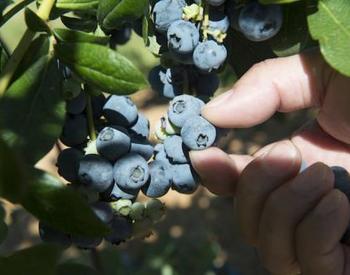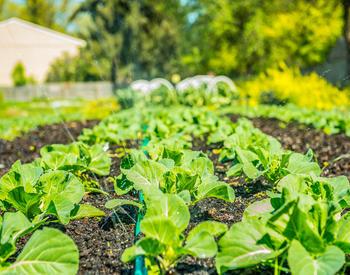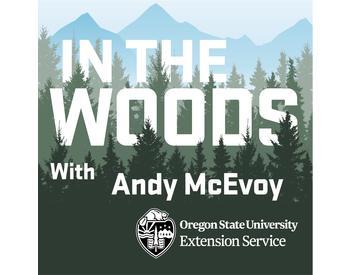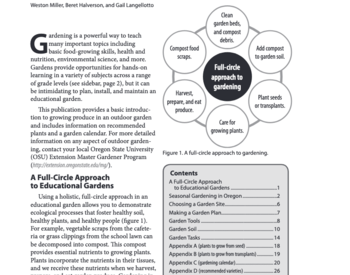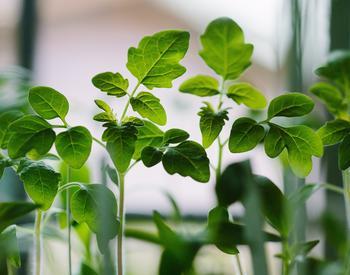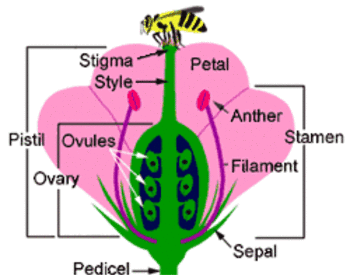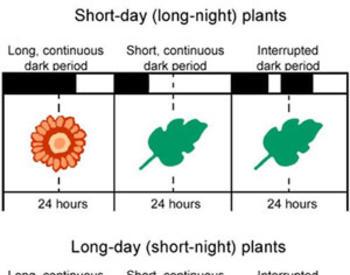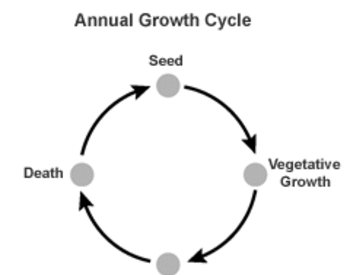Transcript
From the Oregon State University's Extension Service, you are listening to In the Woods with the Forestry and Natural Resources Program. This podcast brings the forest to listeners by sharing the stories and voices of forest scientists, land managers, and enthusiastic members of the public. Each episode, we will bring you research and science based information that aims to offer some insight into what we know and are still learning about forest science and management. Stick around to discover a new topic related to forests on each episode.
Did you know that the In the Woods podcast won an award? That's right. We've been nationally recognized by our peers as being one of the leaders in providing natural resources, content and education through a podcast. But what do you think?
Do you like the topics we've been covering? Are there topics we're missing that you'd like us to cover? How's the quality of the episodes? We've developed a short survey where you can let us know how you feel. Head over to our website at IntheWoodspodcast.org to access the survey. Or you can find a link in this episode's show notes.
The survey should only take about 5 to 10 minutes for you to complete. And when you're done, you'll have the option to enter into a drawing to win some In the Woods swag. We've got magnets, stickers, coffee mugs, and t shirts for you to choose from. We really need your help, so please take a moment to fill out the survey.
The feedback we receive will not only help with improving the podcast, but also help us in the Forestry and Natural Resources Extension Program to ensure we're reaching all our audiences. We look forward to bringing you more engaging content on a wide range of topics with guests from diverse backgrounds, experiences, and expertise.
From all of us at In the Woods, thanks again for listening!
Welcome back to the In the Woods podcast presented by the Forestry and Natural Resources Extension Program at Oregon State University. I'm Scott Leavengood, Extension Specialist in Wood Products. And I have the pleasure this episode of talking with a colleague here at OSU.
Joining me today is Dan Blanchard, Curator of Living Plant Collections for the Oregon State University Campus Arboretum. Hi, Scott. Thank you so much for asking me to be on the podcast. I'm excited to be here. Excellent. Yeah, it's our pleasure. Thanks for joining us today, Dan. And well, tell us a bit about yourself.
Well, I grew up in the upstate area of South Carolina, which is Greenville, Spartanburg for those not familiar, uh, from a young age, I really love learning about the body and, uh, helping people. Which was my reasoning for initially starting college for nursing. Uh, but I found a passion for plants along the way.
I was living in my first apartment and working on completing the prerequisites for nursing school. And started collecting houseplants and at one point I had over 150. Uh, thanks to my mom's suggestion actually of looking into something with plants, I changed my major. And that, uh, led me to Spartanburg Community College, where I completed an associate's degree in horticultural technology.
And then I went on to Clemson University, where I completed a Bachelor of Science in horticulture. I had some amazing professors at both institutions and, um, but overall, I was very inspired by Kevin Parris at Spartanburg Community College, his love for woody plants, in particular magnolias, really ignited a passion for me with what he plants.
Uh, so I have a background in public horticulture, working or interning at a few botanic gardens and Arboreta across the country, many in my home state. Uh, and I moved to Oregon with my spouse in 2019 and started at OSU in the spring of 2021. Uh, so my advisor here was Dr. Ryan Contreras, who's the associate department head and a professor in the department of horticulture.
And, uh, I completed my master's of science here in horticulture at OSU this past August. So my thesis project actually focused on developing interactive tools for public use, mapping, labeling, and getting the OSU campus established as an arboretum. So as you previously mentioned, I'm the curator of living plant collections for the Oregon State university campus arboretum.
But in addition to that role, I'm also a horticulture instructor. So I teach landscape plant materials one and two in person and online. And I was actually the TA for those courses during my master's here. Uh, I will be teaching herbaceous ornamental plant materials online starting this winter. And I oversee four professional and continuing education courses that created from the two landscape plant materials course materials.
And I'm also developing a new course focused on public horticulture that will start this winter on campus. When we met, uh, back in the summer, you told me that, uh, campus was recently recognized as an Arboretum. Uh, for those of us that know little about Arboretums, what does this status recognition mean?
Well, one of the initial goals of getting the campus Arboretum established was gaining ArbNet Level 2 Arboretum Accreditation, which is an international program and the only one of its kind in the world. There are four levels to this program and it's hosted by the Morton Arboretum. The goal is to move up to Level 3 in the next 5 to 10 years.
And so due to the lack of curation over the years, little is known about all the plants that exist in our woody plant collection. So it leaves us uncertain about gaps that exist. So as the curator for the living plant collections of the OSU Campus Arboretum, I maintain plant collection records, which includes mapping existing and new plantings of woody plants here on campus.
Woody plants, for those not completely familiar, are best known as trees and shrubs, but also include woody vines that are often referred to as, uh, lianes or lianes. So, mapping is an ongoing process, and we have over 65,000 woody plants on campus as of the last full inventory in 2012. So by creating a full current inventory, the Arboretum can work with colleges and departments across the university that utilize this woody plant collection as a living learning laboratory to expand the collection for teaching, outreach and engagement opportunities.
Other duties of my position include performing field checks on existing plantings. Updating measurements and adjusting the hardware on the metal tree identification signage. I also lead tours of the Arboretum, update the Arboretum website, work on planning events, and I'm working on developing educational programs for the OSU community and beyond.
Lastly, I work with two teams who help maintain our beautiful campus. That's our Landscape Facilities and University Housing and Dining Landscape and Horticultural Services teams. So with them, I share information about the health of trees, suggest plants for new plantings on campus. Gain information about any new plants that will be installed over the coming year.
And in the future, I'm hoping to collaborate with them to start a volunteer program here at the Arboretum. And what inspired the project? Why did, why did OSU seek this recognition? Well, the OSU campus grounds have a long history starting all the way back in 1871, when it was originally the campus farm at 35 acres.
And in 1889, the university moved to its current location from downtown and has today grown to around 570 acres. The first 35 acres of campus were actually landscaped by George Coote, who planted the original trysting tree around 1880 to 1885. We now have number two and number three that were grown from cuttings of the original tree that was cut down in the mid 80s due to poor health.
A row of conifers, he also planted from the corner of Community Hall to Monroe and 14th. A few of those remain, including two large blue atlas cedars at community hall that were planted in 1892. And the Elm walk in 1905, which was originally, uh, an alternating planting of American Elm and Cork Elm that was later identified as Dutch hybrid Elms.
The American Elms actually from the, uh, Elm Walk were moved up around the MU quad and surrounding buildings, including the women's building in the late 1926, early 1927, uh, following Coote's legacy would be landscape architect professors, Arthur Peck from 1907 to 1948 and Don Martel from 1947 to 1974. Peck is who you must think for the start of our magnificent rhododendron collection here on campus.
He started the collection in 1938 with over 250 plants that were about from about 25 varieties that were all planted originally in front of the MU. Many have been moved as they got too large for their initial location. Don Martel would continue Coote and Peck's. passion for this planting on campus by increasing the diversity of trees and greatly increasing the rhododendron collection with the help of Chuck Woosley, who was the landscape supervisor from the late 1950s to the late 1980s.
Martel really envisioned our campus as a botanical garden or arboretum. He began labeling plants with signs in 1958, and I still find some of those signs from time to time in the landscape. The core of campus is 423 acres, and since May of 2023 is now the accredited state, Oregon State University campus arboretum. The idea of labeling these plants on campus was first mentioned in the Olmsted report of 1909 as a way for people to informally learn plants on campus.
In the A. D. Taylor plan of 1926, which was a revision to the Olmsted report, Mr. Taylor proposed the establishment of an arboretum or botanical garden as part of the campus plan. That same year, the Peavy Arboretum in North Corvallis would open in 1926. The planting of trees, shrubs, perennials, and annuals on campus continues to this day, thanks to the efforts of our incredible landscaping crews and the departments that utilize the incredible resource we all get to enjoy every day.
The plethora of woody plants on campus have been used for teaching many courses over the years, but the collection has not been well documented. Dr. Pat Breen, horticulture professor emeritus, has developed many resources to assist in this effort, including the OSU Landscape Plants website that provides information for about 1,800 landscape plants with many of the locations, uh, of those species found here on campus.
And the Know Your Trees brochure that contains 280 species and varieties found on campus and in Central Park. In 2012, uh, Dr. Ryan Contreras hired a summer intern who would document the entire 570 acres of campus. His data collection showed over 65,000 individual woody plants representing around 600 total species from 244 genera and 95 families.
That included over 8,000 trees and over 7,000 rhododendrons. This incredible diversity deserves to be cataloged, labeled, and used. The issue was there was no way to provide this data to the public in the form of a map or other useful resource. So the inspiration for this project was to bring awareness to this vast collection of woody plants that grace the OSU campus.
Bringing awareness to the collection, to bring that awareness to the collection, there needed to be a user friendly public map that students, faculty, staff, and visitors to the Arboretum could walk around and identify the plants in the collection and labels on the plants in the collection for people, as previously mentioned, to informally learn the plants and learn more about them from scanning the QR codes that actually link with our OSU Landscape Plants website.
And also to increase our public outreach and engagement opportunities as the land grant university for the state of Oregon. From an internal perspective the documentation of plants in the collection allows us to properly curate the collection and fill those gaps in our collection by acquiring and expanding the living plant collection, the living woody plant collection.
But where does the Arboretum acquire these plants, you may ask? Well, of course we can get them from many nurseries, as Oregon is the third largest producer behind California and Florida, but other botanic gardens and Arboreta can open up even more possibilities. We also get many from trial work that happens in our horticulture department and other departments across campus.
To increase the opportunities, an arboretum can look no further than the ArbNet Arboretum Accreditation Program that's sponsored and coordinated by the Morton Arboretum. As I said earlier, it's the only program of its kind in the world, and so working with them, we can actually expand our collection by finding other arboreta that have species that are missing in our collection.
That's really interesting history there, Dan. Tell our listeners a little bit about the process of certification. So as I previously mentioned, there's four levels to the Arbnet Arboretum Accreditation Program. And so, reviewing the four levels, we felt confident going in at a level two. Um, we definitely have the ability to be level three already.
Uh, we just need more signage on campus is one of the main things missing. So to get a level two accreditation, uh, that required a Arboretum or strategic plan for the Arboretum, uh, having an organizational group. 100 plus trees or woody plants on campus labeled, having paid staff and then at least a once a year event and public access to the Arboretum. And then public and educational programs and last a collections policy.
So our collections policy and our strategic plan for the Arboretum can both be found on our website. Um, and if you are interested more in about kind of the future of the Arboretum, I would definitely recommend taking a look and reading through those. We will be rewriting the strategic plan probably in the next five years.
When we reapply for level three accreditation, hopefully this go around. And, um, so you can find out more about kind of where we're at now. We've actually completed almost all of our future goals for our strategic plan and the first year alone. So I'm really excited to see where the next year is going to take us and fulfilling the rest of our goals on that strategic plan.
Uh, as far as our living collections policy, we wanted to keep that very broad since we are a living learning laboratory for multiple colleges and departments here on campus. So while natives are definitely a huge part of our focus being here. Uh, in a mecca of horticulture in the Pacific Northwest, we also wanted to work with a lot of landscape plants that many of our students are learning in, for instance, the classes I teach landscape plant materials one and two.
Um, so we wanted to keep that very vague so that we can continue to improve our resources here on campus for our students, faculty, and staff, and create a place that the community could come to see plants they may never see if they've never traveled outside of the Pacific Northwest.
So I was a student at OSU and I've worked here for almost 30 years, and one of the things about the campus that immediately caught my attention was just how beautiful this campus is, the landscaping in particular, the rhododendrons you've talked about, especially over by the women's building, these are amazing, as are the giant sequoias in the quad, the rogue oaks on the west side of campus just outside my office. So, um, can you, uh, can you tell us a little bit more about the collection and its diversity and are, are college university Arboreta usually campus wide or is OSU unique in that regard?
And then, you know, how many trees can be found on campus? So the majority of colleges and university's Arboreta, at least that I'm aware of are not the campus itself. Typically they're a portion of campus or offsite. Michigan State university and Arizona State university or two that come to mind that like the OSU campus Arboretum are campus wide.
The community college I actually attended in South Carolina also has a campus wide arboretum that is directed by an incredible plants man and instructor, Dr. Kevin Parris. Kevin is best known for his research and introductions of the genus Magnolia. Kay Parris Magnolia, named after his mother, is a dwarf southern magnolia that I've been seeing more and more frequently at garden centers and nurseries here in Oregon.
We actually recently planted one here on campus. Kevin also has some new introductions coming out here in the next few years that I know I'm excited to add to my home garden and the arboretum. One of his upcoming introductions I would like to mention is Melissa Parris, a beautiful hybrid Magnolia with pink and white flowers.
That's named after Kevin's wife who sadly passed away this past December from a battle with cancer. The OSU campus is beautiful throughout the seasons. So it's 570 acres total, but the campus Arboretum, as I mentioned earlier, is the core 423 acres of campus. The diversity of plants that will grow here in the Willamette Valley is incredible.
Think environmental conditions have allowed our campus to turn into a horticultural mecca, which with greenhouse and nursery being the top agricultural commodity in the state of Oregon at around 1.3 to 1.4 billion dollars, provides us with many opportunities to work with industry leaders, not only to showcase the plants they grow, but to allow our ornamental plant breeding and genetics research program a great partnership to get new varieties into the trade.
Our campus has over 8,000 individual trees. In 2012, that number was 8,273 with almost 500 taxa represented. American elm used to be the dominant species here on campus up until the late 1970s, like late 1980s. In the early 1960s, there was over a thousand American elms recorded on campus. In 2012, maple was the most abundant tree genus on campus, which makes sense as elms were being removed due to the possibility of Dutch elm disease.
Maples were being planted in their locations or being planted as a succession plant if the remaining elms would have to be removed. Since the late 1980s, the university has done the practice of deadwood removal on elms to keep them healthy and less likely to become stressed and infected. Dutch elm resistant cultivars of American elms are also gracing our campus now in an effort to continue to provide an urban canopy that lines our streets and shades our campus as represented in the Olmsted Report and Taylor Plans.
Well, unlike our listeners, I have the benefit of being here at OSU with you right now, so I can tap into your extensive knowledge of the plants on this campus. So let's take a walk. Um, something that might be interesting to see is, how about the oldest tree on campus? So we're here at the Oregon White Oaks at Magruder Hall, which, as far as I know, are some of our oldest trees on campus, at over 340 years old.
The tree inside the fence is supposedly older than the one we were standing at here. These trees are actually older than the Declaration of Independence. Wow. This species is an important tree and the dominant one to the Willamette Valley Oak Savannah, which is an extremely diverse ecosystem and supports species not found anywhere else.
Oregon White Oaks provide habitat for over 200 wildlife species. If you are here in late summer and fall, you can see acorn woodpeckers storing acorns in the furrows of the bark that they will feed on during the winter. Well, we've now made the hike from the vet school over to the women's building and you said there was something really interesting you wanted to talk to our listeners about here.
What was that, Dan? Yeah, so we're standing here now at the northeast corner of the women's building and these are some of the American elms that were moved up from lower campus in late 1926, early 1927. It's hard to believe, but around the 1960s, our campus actually had about a thousand American elms.
Many were removed due to building construction, Dutch elm disease practices prior to dead wooding, and an overall decline in health. I'm looking forward to continuing to record the woody plants on campus, trees first, and then shrubs, to find out how many elms we have on campus today. In the spring, there's a symphony of evening Grosbeaks, probably in the hundreds if not thousands, that visit to consume the seeds of the American elms on campus.
There's times where it's been so loud that during plant walks with my students, I almost have to yell the information out to them. Uh, so, it'll be interesting this coming year with Arboretum Tours to see if there's also the symphony behind us as I talk about the American Elms on campus. Well, we've now made the hike over to, uh, Community Hall, formerly known as Benton Hall.
And you said that there was some, some really, uh, interesting history here on, uh, for some of the oldest plants on campus. Is that, is that right? Or older planted trees on campus? Yeah, so we're standing here on the east side of community. And, uh, if we look down, uh, to our east here, we'll see the picturesque elm walk on the other side of 14th.
And the two large blue atlas cedars here on the northeast corner, those were the two planted by George Coote in 1892. This area of campus has some of our oldest planted trees and also some of our most unique trees on campus. Uh, so to wrap up, I, I do want to discuss the living fossil behind us here. It's also the state fossil of Oregon, uh, and fossils of the tree have actually been found in the John Day fossil beds in eastern Oregon.
So this is the Dawn Redwood, a tree thought to be extinct until the early 1940s when it was found in China. The one we are admiring was planted by, uh, from a one year old ceiling in 1949. We were gifted three trees by Ralph Chaney, who was a paleobotanist at the University of California, and one was planted here, another behind Moreland Hall, which was the original forestry building.
Uh, and in the College of Forestry, oh sorry, that tree was planted in the College of Forestry's tree nursery and at Peavy Arboretum upstream from the forestry cabin. Uh, I've been told this is the only survivor of the original three trees, but I must say the oldest specimen at Peavy Arboretum is a beauty and one I would enjoy finding out more about its history.
I do know that some of the, uh, Dawn Redwoods that are in front of Peavy Hall here on campus, uh, were actually seedlings. from the tree up at the Peavy Arboretum. So, uh, where can people get more information about the OSU Arboretum? So the best place to get information about the campus arboretum is to visit our website.
There are links on there to request a tour, reference a self guided tour of some of our oldest and or unique trees on campus. More self guided tours will be added here in the coming months. There's a historical timeline of the campus grounds. Our strategic plan and living collections policy can also be found there.
There's also the option to make a gift to help fund signage, employment opportunities, and special events. And you can also access the interactive arboretum map that will continue to be updated. I mentioned requesting a tour and I'm also hoping to see start a monthly Saturday morning tour, lunch tours a couple of times a term for faculty, staff and students.
And we'll continue to give tours for special events like family weekend in the spring and fall. All right. Well, before we wrap up this episode, I have a few more questions for you and what we call the lightning round.
And our first question is always, what is your favorite tree species? Oh, well, that's a tough question for a guy who has a passion for woody plants, especially trees. Growing up in the southeast, magnolias always come to mind, but during college, conifers became my favorite, enough to gain the nickname Dan the Conifer Man.
I really enjoy deciduous conifers. There are only five genera and about 20 species. I think it's probably a tie between bald cypress and dawn redwood. The age of some of the bald cypress in eastern North Carolina on the Black River is around 2,600 years old. And the history of the Dawn Redwood, which is thought to be extinct until it was found in China in the 1940s.
Uh, I really have a passion for history as well as plants, so combining those two things really makes me, uh, super excited about those two species. Also enjoy the beautiful fall colors of reddish brown to copper that each of them, uh, have in the fall, which is a sight to behold. So they are deciduous conifers.
So they have not, uh, died in the winter. They are just dormant and will re leaf out in the fall, or excuse me, in the spring. I will say though, Western larch has become another favorite here since moving to the Pacific Northwest. The beautiful yellow fall color is hard to beat. And, uh, what's a unique tool that you use that helps you with your work?
Well, when I go out to collect data, I always take four things with me. That's my phone that I use ArcGIS FieldMaps on to collect, to connect to the online web map. I take a Trimble GNSS receiver to get GPS coordinates that are typically around 6 to 12 inches, uh, within accuracy. I take a calibrated diameter tape better known as a d tape for measuring dbh, that's the diameter at breast height, and a laser rangefinder for measuring the tree heights.
These all are helpful in recording data, but one of the greatest resources I use and recommend to everyone is the OSU Landscape Plants website. Developed by horticulture emeritus professor, Dr. Pat Breen.
When I'm struggling to remember what species a particular plant is, I can go to Dr. Breen's site and search the genus and then go through the different species to assist in confirming the identification. The QR codes on the tree signage across campus and the more info link that can be found within the pop up information for each plant on the web map, will actually take you to more information about that species that can be found on the OSU Landscape Plants website.
And lastly, what other resources can you share for a listener that would like to learn more about the OSU Campus Arboretum, or simply Arboretums in general? Well, for Arboretums in general, I would highly recommend checking out the ArbNet website. Arbnet.org. If you click on the Morton Register at the top, you can find an arboretum around the world, accredited or non accredited, that is requested to be added to the Morton Register.
I would highly encourage all organizations that are focused on woody plant collections to review their website and consider joining their program. For the OSU Campus Arboretum, check out our website at campusarb.oregonstate.edu. You can also reach out to me using the send email listed beneath the mail address for the Arboretum, or find me under the people tab on the website.
Dan, thank you so much for spending some time with me today. Scott, thank you so much for the opportunity to come and talk with you and share with the listeners more about the incredible woody plant collection here on campus that makes up the Oregon State University Campus Arboretum. Well, this concludes another episode of OSU forestry and natural resource extensions in the woods podcast series.
Thanks for listening and don't forget to subscribe.
Thank you so much for listening. Show notes with links mentioned on each episode are available on our website @inthewoodspodcast.org. We'd love to hear from you. Visit the Tell Us What You Think tab on our website to leave us a comment, suggest a guest or topic, or ask a question that can be featured in a future episode.
And give us your feedback by filling out our survey. The In the Woods Podcast is produced by Lauren Grand, Jacob Putney, Scott Leavengood, and Stephen Fitzgerald, who are all members of the Oregon State University Forestry and Natural Resources Extension team. Episodes are edited and produced by Kellan Soriano.
Music for In the Woods was composed by Jeffrey Hino, and graphic design was created by Christina Friehauf. We hope you enjoyed the episode and can't wait to talk to you again next time. Until then, what's in your woods?
In this episode, Scott Leavengood tours OSU's main campus with Dan Blanchard to learn about the university's rich history of woody plants and the process of turning OSU into an accredited arboretum.



